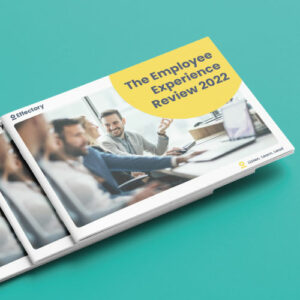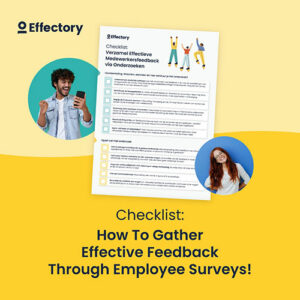DEI&B is an increasingly important part of many organizations’ missions. HR plays a crucial role in strengthening a workplace’s ability to be diverse and inclusive. Employee feedback can provide essential insights from the frontline that can inform an effective DEI&B strategy.
HR can measure DEI&B outcomes for a more successful workplace

Why diversity & inclusion is important
The modern workforce is more diverse than ever before. However, research has shown that employees belonging to minority groups are more likely to be dissatisfied with their work. They will also experience more stress on the job. This is why companies have started to look at how they can increase Diversity, Equity, Inclusion, and Belonging (DEI&B). The aim is to improve the workplace environment for all employees.
When it comes to business growth, DEI&B is essential. Major companies like Panasonic, The Lego Group, and Wayfair have used people analytics to improve DEI&B within their organizations.
In this article, we’ll explore the definition of DEI&B. We’ll also outline how employee listening can be an essential tool for improving diversity initiatives in the workplace.
Listen to employees to make them feel included
Tracking the success of diversity initiatives can be difficult. Effectory is an employee listening solution that plugs HR and management into employee feedback. It empowers organizations to gain valuable insights about their people and identify opportunities for improvements. Consider performing Effectory’s scientifically-validated question set on inclusion in order to find out how inclusive employees find your organization.
Download the Employee Experience Review
Discover how employees around the world are experiencing different parts of the employee journey and how this affects the employee experience.
DownloadWhat Is DEI&B?
The acronym DEI&B stands for Diversity, Equity, Inclusion, and Belonging. DEI&B is a phrase that’s been gaining traction in the world of HR. This is thanks to “diversity” becoming an issue at the forefront of conversations about workplace culture.
Diversity, equity, inclusion, and belonging are different ways of thinking about the same thing: what makes a workplace welcoming and inclusive for everyone?
While these terms may be easily confused, it’s important to distinguish their meanings. According to the Milken Institute for Public Health at George Washington University”: “Equality means each individual or group of people is given the same resources or opportunities. Equity recognizes that each person has different circumstances and allocates the exact resources and opportunities needed to reach an equal outcome.”
Let’s break down what each of these terms means:
- Diversity in the workplace is the inclusion of individuals from different genders, races, sexual orientations, sexual identities, ages, physical abilities, and educational backgrounds.
- Equity means that each of those diverse employees is given equal access to opportunities in the workplace.
- Inclusion is about ensuring that all employees are given a place at the table when it comes to decision-making.
Belonging is the most recent term to be included in the acronym. Belonging is a measure of whether the company’s diversity and inclusion efforts are working. Employees should feel a sense of belonging within the organization regardless of their background. Essentially, the concept of belonging measures whether DE&I efforts have been successful.
Why is DEI&B Important?
DEI&B is imperative to any successful workplace. There are proven links between diversity and employee engagement. A 2013 report from Deloitte states:
employees who perceive their organisation is committed to, and supportive of, diversity and who feel included, are 80% more likely to believe they work in a high performing organisation, in comparison to a workplace perceived as having low commitment and support for diversity and employees not feeling included.
Not only that, but diverse organizations are proven to be more financially successful too. A Gallup survey found that a “combination of employee engagement and gender diversity resulted in 46% to 58% higher financial performance”.
By creating a culture that genuinely values people regardless of their gender identity, sexual orientation, race, or any other factor that makes them who they are, organizations make themselves a better place to work. And more successful.
Make employees safe and comfortable
When employees feel safe and comfortable, they’re more likely to bring their whole selves to work. This makes them more able to focus on their work without having to worry about their background impacting how they’re treated. All employees should be able to come to work without fear of harassment because of their identities.
In fact, if your employees aren’t feeling this sense of belonging at work, they might be worried they’ll lose their jobs or otherwise face discrimination. Employees who feel valued as part of the team are more productive, have better work quality, and are less likely to leave the company because they feel that their needs aren’t being met.
Emma Turner of Diversity and Ability says, “Diversity is a business strategy that needs to be built into every decision.”
How to gather feedback from your employees
The definitive checklist for creating your employee engagement survey.
DownloadHR’s Role in DEI&B
When people talk about DEI&B at work, they often focus on the responsibility of management to foster an inclusive culture. This is one where employees feel safe and comfortable expressing themselves. It’s important to remember that a workplace culture that values DEI&B begins with everyone, including the HR department.
Diversity is usually at the forefront of people’s minds when it comes to recruitment. But the goal is not just hiring diverse people—it’s cultivating an environment where everyone feels comfortable and welcome. It’s important to track DEI&B initiatives throughout the entire employee experience.
HR and diversity & inclusion go hand-in-hand
Human resources departments are often the first to hear about problems within a company. From complaints of harassment to requests for accommodations, HR is often the liaison between the employee and management. It’s also partially HR’s role to ensure a strong company culture where team cohesion is a major priority in order to foster inclusion.
According to The Relation Between Group Cohesiveness and Performance: An Integration, cohesion refers to the relationship between individual employees and their team. “Team cohesion is seen as a mixture of characteristics such as interpersonal attraction, the pride of belonging to the group and commitment to solve the tasks.”
How Employee Listening Helps with DEI&B
Employee listening is vital to the success of equity, diversity, and inclusion initiatives because it helps you to understand where your employees are coming from and what their needs are. It also lets HR and management discover who inclusive the workplace feels, and allows for those metrics to be compared to the likes of engagement and productivity.
When you to listen to your employees’ feedback, they will feel heard and valued by the company leadership, which will go a long way toward fostering loyalty in the workplace. One of the most challenging parts of creating change in a work environment is acknowledging that there are blind spots. These can also be understood “leadership gaps”, a topic we discuss extensively in our recent whitepaper about employee listening and change management.
Employee listening can help you identify problems or difficulties, connect with employees on an emotional level, and find out whether your company’s DEI&B goals are being met. When you ask questions of your staff, their answers may point to problem areas that need attention. For example, if an employee says that they feel their ideas are often ignored during meetings, then that would be an indication that the way the meetings are set up may not be conducive to good discussion.
Workshop ideas to improve inclusion
While employee listening can use qualitative measures to track inclusion and belonging, other processes may be necessary to monitor quantitative ones like diversity and equity. Employee surveys are a necessary tool to track both diversity and equity to ensure the company is on the right track.
Measuring a topic such as inclusion in a quantifiable way can produce data that can inform concrete actions. For example, we recently partnered with the Inclusion Studio, who can offer workshops to organizations who identify points of improvement after performing an inclusion-themed survey via the Effectory platform.
How GDPR Impacts the Collection of Diversity Data
It’s important to note that state and trans-state regulation has a major impact on the collection of employee data.
On May 25, 2018, the European Union adopted the General Data Protection Regulation (GDPR). This policy regulates the collection and use of the personal data of EU residents. The law is even stricter when it comes to “special categories of personal data,” which include “race, ethnicity, political views, religion, spiritual or philosophical beliefs, sexual orientation, and sex life data.”
There are exceptions to the rule. If an employee gives clear consent on the data being collected, for example, then the company is still complying with the regulation. Be sure to review the official GDPR policy before collecting any employee data. These laws do not apply to citizens of countries outside of the EU, and can therefore be ignored by North American companies.
Book a free demo. See our solutions in action.
Effectory is Europe's Leading provider of Employee Listening Solutions. Schedule a product demo and discover how to enhance your employees' engagement.
Demo request

